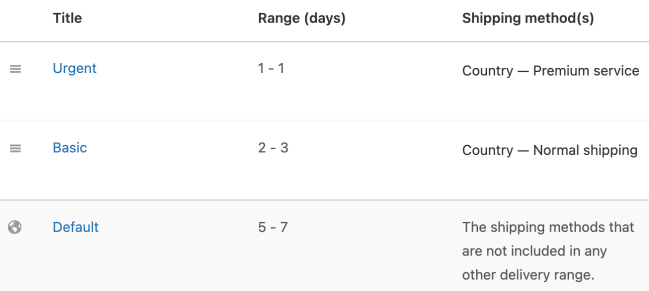This article explains how to configure Order Delivery to define different delivery ranges based on shipping methods. This way, you can offer your customers different prices and delivery times to receive their orders.
Delivery Ranges Configuration
↑ Back to topBy using delivery ranges, you give more options to your customers on when they’d like to receive their order. Below, we’ll go through an example of setting up 3 delivery ranges:
- Urgent (1 – 1): This will be our most expensive shipment since it’s the fastest. The 1-1 range signifies that the delivery of the order will happen within 24 hours.
- Basic (2–3): This is our standard shipping method, offering a lower shipping price.
- Default (5 – 7): This is the fallback method that will be utilized by the rest of the shipping methods that do not meet the conditions.

Notes: Keep in mind that the Delivery ranges must be ordered from the most specific to the most generic, similar to what happens with Shipping Zones. You can find more information here about Shipping Zones.
We also recommend reviewing our document on how Delivery ranges work.
Checkout Form Behavior
↑ Back to topNow that we have configured the delivery ranges, let’s see what this will look like during checkout:
After a customer adds the billing and shipping address data, they would then select their preferred shipping method. If, for example, that method offers the Urgent delivery range, the minimum time (remember that the range was 1-1, meaning within 24 hours if possible).
This timing will be included in the calculations alongside the Lead time in days and the Shipping days to properly render the delivery calendar with valid delivery dates for the customer to choose.
Note: Based on your shop’s availability and the lead time needed to prepare the product, it’s possible that even if the delivery range has been configured to offer a 24-hour order delivery, it won’t be possible to achieve that.
Keep that in mind while configuring your the Shipping settings to avoid any miscommunication with your customers.
The same calculations would apply if a customer selects the Basic option for a delivery range, which has a 2-3 range; the minimum days would be added, which are 2, together with the Lead time in days and the Shipping days to determine the earlier delivery date presented to the customer on the front-end.
Conclusion
↑ Back to topIf you need more information regarding how our Order Delivery for WooCommerce is working, you can review the rest of our documentation here.
Do you have more questions on how you can properly configure your online shop’s order delivery calculation? Feel free to reach out to our team, and we’d be happy to help.
